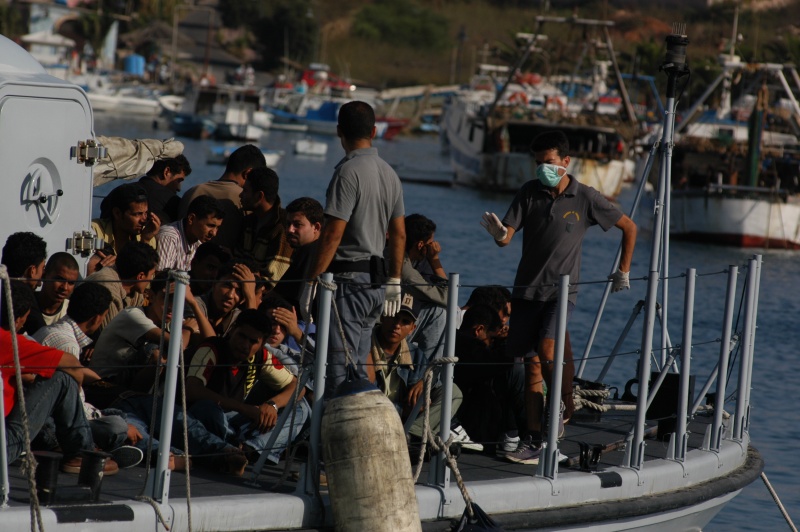Group 7 Italy (Alessandra, Paolo, Angelica)
IMMIGRATION = INTEGRATION
Called the world's most complex social phenomenon, immigration represents a multiple-faced world related to the entire planet.
History
Most of the migratory population fled, and runs away now, from their country of origin because of problems such as: war, epidemics, poverty. To solve these problems, at the political level, the countries of origin and destination could tighten the so-called "bilateral agreements" so that they could have controlled migration flows and plan them, but no one cared. In the early 80's Europe witnessed to a crisis of developing countries: populations whose living conditions deteriorated steadily and were forced to take refuge in Italy with the perspective of a better future. Italy from the migration point of view, appears to be a very particular country because, throughout history, has been able to experience both sides of the coin: initially outflows and, subsequently, in the entry. It has not always been an interesting territory for thousands of foreigners, but the protagonist of a largest migratory exodus.
The first Italian legislative regulation of migration, which allowed foreign workers to enjoy the same rights of Italian workers, was approved with Law No. 943 30th December 1986. On 28 February 1990, however, it was approved the so-called "Martelli Law No. 39", with which a more and more substantial immigration phenomenon was adjusted and refugee status was granted.
March 7th 1991 started a major immigration current, remembered as "The exodus of the Albanians." In fact, the destruction of a political-social system caused tens of thousands of Albanians to flee to the coast of Apulia. The port of Brindisi hosted crowded ships of migrants, about 27,000, welcomed by the citizens of the place, which escaped the crisis due to the collapse of the Berlin Wall.
It should also be remembered August 8 1991, when the port of Bari docked the Vlora, a merchant ship returning from Cuba, full of brown sugar, which was attacked the day before during landing operations in Durres from about 20,000 Albanians , which forced the captain to sail to Italy. This event was to mark the largest landing ever in Italy with a single ship, and it is for this same reason that Gianni Amelio, Italian filmmaker, produced a film called "Lamerica" (1994), which tells the story of Fiore, a big money-maker, and his young assistant Louis landed in Albania.
Also in the period between the ‘86 and the 90's, Italy was hosted about 25,000 Egyptians.
If emigration to Italy previously had amounted to large numbers, we can say that since 1971 it has almost completely ceased. The number of expatriates equalled that of the returnees. Since 1980 our "country of migrants" turned into "country of immigrants".
Reasons of immigration in Italy
As mentioned above, immigration in Italy came from various developing countries, such as Africa, South Africa, Nigeria, Senegal and others like Egypt, Albania.
The causes that characterized this phenomenon are multiple and can be placed on three distinct levels:
1. economic;
2. Political;
3. Family.
From the economic point of view, these people escaped the crisis and poverty and the only way out was found to be the emigration to another country, a way to face the future in a better condition, looking for a job.
From a political point of view, the most common reasons are: dictatorships, persecution, wars and genocides that drove families to seek freedom outside of their countries.
As for family reasons, the most common one is to escape from a domineering father or a family that forces the individual, often a minor, to labor.
There were, and there still are, valid reasons for which a refugee protects himself running away from his/her own country.
Effects and consequences of migratory waves
In 1987 the growth of the migratory population increased of 27%, all regularized by a legislature and, unfortunately, in 1989 it underwent a snapshot decrease by about 24% over the previous year.
In 1991 the foreign population doubled from about 315,000 to 630,000 migrants. The latter in particular was mostly due to the Albanians who fled because of communism.

https://flic.kr/p/4Nwjsj
Sources:
-https://it.wikipedia.org/wiki/Legge_Martelli
http://www.repubblica.it/solidarieta/immigrazione/2011/03/06/news/1991_il_primo_grande_esodo_dall_albania_verso_l_italia-13263392/
-https://it.wikipedia.org/wiki/Immigrazione_in_Italia.
